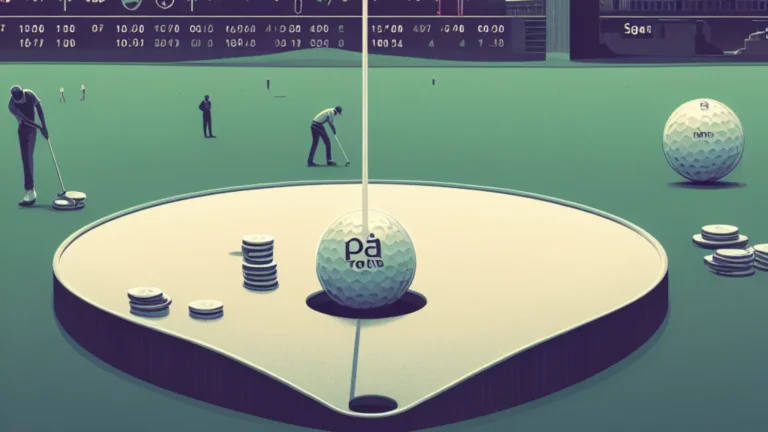How to Putt in Golf for Beginners
Putting is frequently seen as the most important aspect of the game of golf. The difference between great and average players is their skill. As a beginner, mastering the art of putting can be difficult, but with the right techniques, practice, and patience, you can dramatically improve your putting game. This comprehensive guide will provide you with valuable insights and tips on how to putt in golf for beginners, allowing you to improve your scores and enjoy the game more.
The significance of a good putting stroke
A consistent and smooth putt in golf is the foundation of success in golf for beginners. A good putting stroke should be a pendulum-like motion, with the arms and shoulders coordinating fluidly and controllably. Developing a repeatable putting stroke will boost your confidence on the green and allow you to sink more putts.
The Setup
Setting up correctly is essential for a successful putting stroke in golf for beginners. Begin by ensuring that your eyes are directly over the ball and your feet are shoulder width apart. Bend your knees slightly, but keep your back straight and your head still. Position the putter head behind the ball, face square to the target line. Grip the putter lightly but firmly, keeping your hands comfortably positioned and your elbows tucked in close to your body.
Aim and Alignment
Proper aim and alignment are critical components of putting in golf for beginners. Before you make your putting stroke, take a moment to visualize the path you want the ball to take towards the hole. To properly align your putter face and body, use the putter’s line on the head or the lines on the green. Remember that even minor misalignments can cause your putts to veer off course.
Distance Control
Beginner golfers must develop a good sense of distance control. Green speed, uphill or downhill slopes, and break (the amount of curve the ball takes as a result of the green’s slope) all influence the distance your ball travels. Practice on various green conditions to get a sense of how hard or soft you need to strike the ball to achieve the desired distance.
Reading Greens
Reading greens is an art form in and of itself, and it is a necessary skill for beginners when putting in golf. Before you putt, examine the green’s contours, slopes, and breaks. Look for subtle clues, such as discoloration or grain patterns, that can indicate which way the ball will break. Create a routine for reading greens and trust your own judgment once you’ve made your decision.
Practice, Practice, Practice
Putting, like all other golf skills, requires consistent practice. Set aside time to improve your putting stroke, aim, and distance control. Set up a putting green at home or make regular visits to your local course’s practice area. Experiment with various drills and putting aids to help you learn the proper technique and gain confidence on the greens.
FAQs
What is the right putting stance for beginners?
For beginners, the proper putting stance is to position your feet shoulder-width apart, knees slightly bent, and eyes directly over the ball. Keep your back straight and your head still, and grip the putter lightly but firmly, elbows tucked close to your body.
How do I aim and position my putter properly?
To properly aim and align your putter, visualize the path you want the ball to take towards the hole. To properly align your putter face and body, use the putter’s line on the head or the lines on the green. Ensure that your shoulders, hips, and feet are parallel to the target line.
What is the correct putting stroke for beginners?
For beginners, the proper putt in golf is a pendulum-like motion in which your arms and shoulders work together fluidly and controllably. Avoid excessive wrist break or hand action, instead focusing on a smooth, back-and-forth pendulum motion.
How do I control the distance when putting?
To control distance when putting, practice using a consistent stroke length and tempo. Practice on various green speeds and slopes to get a sense of how hard or soft you need to strike the ball to achieve the desired distance. Uphill/downhill slopes, as well as green speed, will all influence the distance.
How important is it to read the green when putting?
Reading the green is critical to successful putting. Before you putt, examine the green’s contours, slopes, and breaks. Look for subtle clues, such as discoloration or grain patterns, that can indicate which way the ball will break. Developing a routine for reading greens will allow you to make more accurate putts.
What are some good putting drills for beginners?
Some effective putting drills for beginners include the “ladder drill” (placing tees or markers at different distances to practice distance control), the “gate drill” (placing two tees or markers to create a gate for aim and alignment practice), and the “string drill” (practicing straight putts with a string or chalk line).
How often should a beginner practice putting? Beginners should aim to practice putting on a regular basis, preferably multiple times per week. Dedicating time to improving your putt in golf, aim, and distance control will help you learn the proper techniques and gain confidence on the greens.
What’s the significance of a consistent putting grip?
A consistent putting grip is required for a repeatable and precise putting stroke. Grip the putter lightly but firmly, keeping your hands comfortably positioned and your elbows tucked in close to your body. Experiment with various grip styles (reverse, conventional, etc.) to determine which works best for you.
Should beginners use a putting aid or training device?
Using a putting aid or training device can help beginners develop proper technique and form. Devices such as mirrors, alignment sticks, and gates can provide valuable feedback and reinforcement during practice sessions.
How can beginners maintain confidence and focus while putting?
Create a pre-putt routine that allows you to remain present and relaxed while putting. Visualize the putt, take a few deep breaths, and believe in your stroke. Celebrate small victories and don’t dwell on missed putts; keep a positive attitude throughout your round.
Conclusion
Putt in golf for beginners is a skill that can be learned with dedication, patience, and the proper techniques. By following the advice provided in this guide, you will be well on your way to developing a consistent and reliable putting stroke. Remember to practice regularly, focus on the fundamentals, and maintain your confidence on the greens. With time and effort, you’ll notice a significant improvement in your putting game, resulting in lower scores and a more enjoyable golf experience.







